Abstract
Spontaneous imbibition is a phenomenon of fluid displacement under the action of capillary force, which is of great significance to reservoir protection, enhanced oil recovery, flow-back optimization, and fracturing fluid selection in unconventional oil and gas reservoirs. Remarkable progress has been made in the imbibition research of oil and gas, and the overall research situation of research needs to be analyzed more systematically. This paper aims to provide a scientometric review of imbibition studies in unconventional reservoirs from 2010 to 2021. A total of 1810 papers are collected from the Web of Science Core Correction database based on selected keywords and paper types. Using CiteSpace software, a quantitative scientific analysis is carried out on the main aspects of national cooperation, institutional cooperation, scholarly cooperation, keyword co-occurrence, journal co-citation, article co-citation, and keyword clustering. The principal research countries, institutions, scholars, keywords, published journals, influential articles, and main research clusters are obtained, and the cooperation relationship is analyzed from the centrality and number of publications. At the end of the paper, the existing knowledge areas are discussed based on the analysis of scientometric results. This study constructs a comprehensive research knowledge map of imbibition, providing relevant research with a more valuable and in-depth understanding of the field.
1. Introduction
In recent years, the exploitation of unconventional oil and gas resources (shale oil and gas, tight oil and gas, and hydrates) has received extensive attention from international scholars, which has greatly alleviated the contradiction between energy supply [1]. Spontaneous imbibition refers to the process in which the wetting phase in the rock spontaneously displaces the non-wetting phase under the action of capillary force [2]. Unconventional reservoirs generally demonstrate the characteristics of low porosity, low permeability, and high capillary force, resulting in a significant spontaneous imbibition effect driven by capillary force [3]. The spontaneous imbibition of oil and gas reservoirs should be studied in-depth in terms of wellbore stability, fracturing fluid flow back, enhanced oil recovery, factuality evaluation, and reservoir damage analysis [4]. With the continuous exploitation of unconventional oil and gas resources, spontaneous imbibition has an increasing influence on production efficiency, which has become a key problem that needs to be solved urgently in oil and gas exploitation [5]. The use of gas to improve reservoir wettability is a versatile and effective approach to relieve fluid plugging that occurs during imbibition. Fluorochemicals have a high density of fluorine groups and thermal stability, which can change reservoir wettability to more favorable conditions for liquids [6]. At present, the study of imbibition in unconventional reservoirs has become an international research hotspot.
The predecessors have also conducted a lot of research and retrospective analysis on imbibition in unconventional reservoirs. The curved streamlines in the fractures of natural porous media have fractal characteristics. The fractal method is widely used in the study of the imbibition process of porous media, and the parametric equations used in the existing fractal permeability models are also different [7]. An in-depth study and analysis of the imbibition process can help to improve the efficiency of oil and gas production. The research methods mainly include capillary imbibition mechanical analysis and the establishment of a rock imbibition model. The main controlling factors of imbibition include rock and fluid properties, as well as the effects of temperature and pressure [8]. Imbibition of porous layers plays an important role in both natural phenomena and technological applications. There is a “dynamic non-equilibrium” (DNE) phenomenon in the process of water flow imbibition in soil, which can be studied using the model and numerical simulation methods. Imbibition studies on porous layers urgently require precise measurements to quantify dynamic effects [9]. In the phase transition of oil and gas, complex imbibition phenomena affect the transport of heat, mass, and particles. With the continuous development of research tools for the coupled imbibition process in porous layers, the research efficiency is further improved [10].
Due to the transfer of research hotspots, the research progress of imbibition in various directions in different time periods is inconsistent. It is difficult to accurately review the research status of various aspects of imbibition, and it also puts forward high requirements for researchers’ academic accumulation. In addition, solely manual analysis is easily affected by personal opinions, and it is difficult to obtain rational and accurate results. The scientometric analysis is a powerful tool for quantitative analysis of academic literature based on mathematical and statistical methods, and its purpose is to elucidate scientific development processes and structural relationships based on knowledge areas. This paper adopts scientometric methods (such as cooperation analysis, co-occurrence analysis, cluster analysis) to conduct an objective and comprehensive analysis of imbibition research in unconventional reservoirs; the main research method framework is shown in Figure 1.
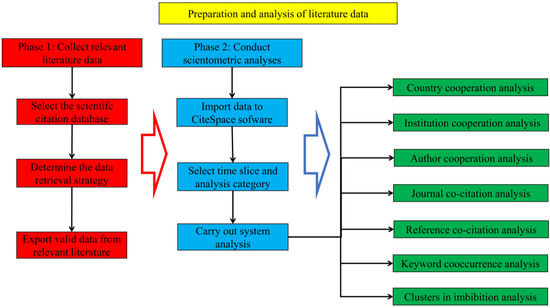
Figure 1.
Analytical method framework.
2. Research Methodology
On the basis of previous research, the scope of the literature search is determined according to the research hotspots year by year, and literature data are collected. The scientometric analysis includes countries, authors, institutions, keywords, and journals. Reasonable scientometric analysis provides a basis for determining the focus of imbibition research in unconventional reservoirs.
2.1. Literature Collection Work
For literature review work, it is critical to collect relevant, accurate, and comprehensive literature data. This paper uses the ISI Web of Science as the retrieval platform and uses the Science Network core collection database to collect literature data. The database is internationally recognized as the most comprehensive and authoritative scientific citation database, containing a large number of the world’s most influential papers [11]. The quality and quantity of articles in this database are sufficient to support the completion of this review.
Literature retrieval strategies and methods greatly affect the accuracy of the scientometric analysis. Considering that imbibition mainly occurs in shale, tight reservoirs, hydrates, and typical porous media, the exploitation of extraordinary oil and gas resources has achieved rapid development in the past 10 years. Therefore, the search keywords were finally determined (as shale and imbibition, or tight reservoir and imbibition, or hydrate and imbibition, or porous media and imbibition), where the language, document type, and period are set as “English”, “Thesis”, “Article and Review”, and “2010–2021” (about 10 years, search date was 27 November 2021). Based on this search strategy, a total of 1810 papers were retrieved and exported.
After completing the relevant literature search, a scientometric analysis is performed. The bibliographic data exported from the core database includes complete titles, abstracts, keywords, and references, and finally it was saved in text format and imported into Citespace software.
2.2. Analysis of Citespace Software
CiteSpace developed by Chen is an important tool for analyzing and visualizing citation networks [12]. This study uses CiteSpace version 5.8.R2 conducts research including national cooperation network analysis, institutional cooperation network analysis, author cooperation network analysis, journal citation analysis, reference citation analysis, keyword co-occurrence analysis, and cluster analysis. After a series of collaborative analyses, Citespace software creates a comprehensive collaborative analysis graph based on the results. The centrality is a quantitative measure of the importance of nodes in these graphs. A node with a large centrality value (greater than 0.1) means it plays a central role in visualizing the network, called turning points, identified by color changes. The centrality can be expressed by Formula (1) [13].
where gjk denotes the number of shortest paths from node j to node k, and nijk denotes the number of these paths through node i. Furthermore, for the following network graphs generated by CiteSpace, the colors of nodes and links ranging from cool to warm tones correspond to different years from the past to the present.
3. Scientometric Analysis
In this section, the imbibition of unconventional reservoirs is reviewed according to the research method of scientometric analysis. The analysis results are as follows.
3.1. Characteristic Analysis of Imported Literature
According to the sorting and summary of the retrieval results of unconventional reservoir imbibition, the number of publications and citations on this topic each year is shown in Figure 2. According to the data changes in Figure 2, it can be seen that the number of publications from 2010 to 2014 is relatively small, and the fluctuations are relatively stable. This stage is the early stage of imbibition research, where various research methods and various experimental equipment for imbibition research have been developed, laying a solid foundation for future research. In the past 10 years, the shale gas revolution in the United States has achieved breakthroughs, and shale oil and gas production has increased rapidly [14]. Before 2010, the United States was the world’s largest importer of oil and gas. The United States became a net exporter of natural gas in 2017, driven by rapid growth in oil and gas production. In 2019, the United States became a net exporter of crude oil, which shocked the world’s oil and gas scholars [15]. The increase in oil and gas production has attracted scholars to do much research on imbibition, and published a large number of related research papers. In February 2015, important progress was made in shale gas exploration in the Ordos area of China, attracting numerous scholars in the field of shale oil and gas research [16]. Issues related to shale gas extraction have become a research hotspot, and a large number of high-quality papers and research results on the imbibition process research have been published in the following years. The year 2015 is a critical node for imbibition research in unconventional reservoirs. The publications on imbibition research have grown significantly since 2014 at an average annual growth rate of 23.5%, and the number of publications has increased from 83 in 2014 to 294 in 2020. The number of citations increased from 1183 in 2014 to 6014 in 2020, with an average annual growth rate of 31.3%. China’s research on imbibition in unconventional reservoirs has made rapid progress in recent years, the number of publications has increased from 23 in 2014 to 140 in 2020, and the average growth rate has reached an astonishing 35.1%. The number of citations increased from 138 words in 2014 to 2102 in 2020, with an average growth rate of 57.4%. It can be seen that since 2015, a large number of researchers, especially Chinese scholars, have paid more attention to the field of imbibition in unconventional reservoirs. The number and citations of Chinese scholars’ published papers on imbibition are shown in Figure 3.
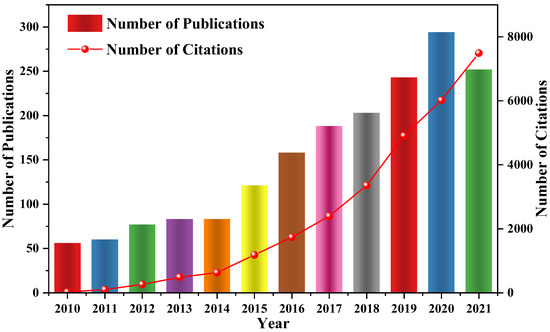
Figure 2.
Number of publications and citations from 2010 to 2021.
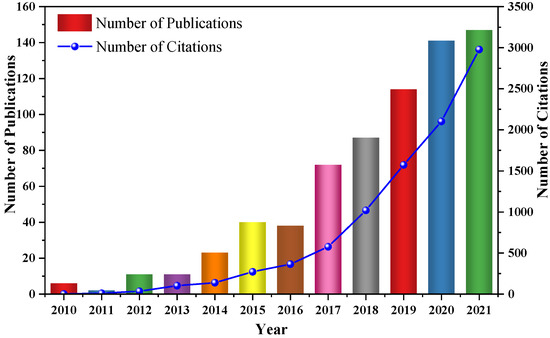
Figure 3.
Number of publications and citations from 2010 to 2021 in China.
With the development of globalization, academic exchanges and cooperation networks are becoming more and more frequent. Identifying and summarizing cooperation relationships at various levels is helpful to understand the current status of unconventional reservoir imbibition research cooperation. Using Citespace software, the national cooperation network, institutional cooperation network, and author cooperation network are established through the analysis of published articles, and the cooperation relationship is explained from the macro- and micro-levels. In the graph obtained after scientific analysis, the node size represents the total number of articles published by countries, institutions, or authors, and the thickness of the links represents the strength of the cooperative relationship in the cooperative analysis graph.
3.1.1. Analysis of National Cooperation
Figure 4 is a map of the national cooperation network for imbibition research in unconventional reservoirs. According to the size of the nodes in the map, the leading countries in this field can be identified. The five countries with the largest number of publications are China (688 papers), the United States (560 papers), Canada (182 papers), Australia (119 papers), and Iran (104 papers). A large number of published papers show that these countries have made different degrees of progress in research in this field, and have made outstanding contributions to imbibition research in unconventional reservoirs. Especially in the past 10 years, Chinese scholars have published a large number of valuable papers, making the most outstanding contribution to the exploitation of oil and gas. In terms of international cooperation, researchers from China, the United States, and Canada, as well as other countries, work closely with each other and publish a large number of influential articles.
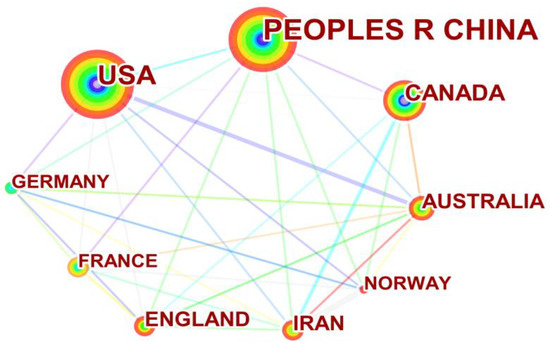
Figure 4.
Country cooperation network.
In addition, the centrality of each node is calculated by Equation (1), and the key nodes are determined according to the magnitude of the value. In the country cooperation graph in Figure 4, countries with high centrality have larger node volumes, indicating that the country plays an important role in the development of imbibition research. It can be seen that the United States (centrality = 0.36), China (centrality = 0.27), and Canada (centrality = 0.09) are the three key nodes in this network. Obviously, China plays an important role in international cooperation and exchanges in this field, which is closely related to China’s vigorous development of oil and gas in recent years. Unconventional oil and gas are very important to the development of oil and gas resources, and shale oil and gas accounts for a very large proportion of unconventional oil and gas reserves. China is rich in shale oil reserves, with proven reserves of 476.4 × 108 t, mainly distributed in nine basins including Ordos Basin, Songliao Basin, and Junggar Basin in inland China [17]. Shale oil is generally extracted by fracturing technology. Field experience shows that in the process of well preservation after fracturing, the imbibition rate of fracturing fluid has a great influence on shale oil recovery [4]. China has made outstanding contributions to the world’s unconventional reservoir imbibition research. Since 2014, China’s continental shale oil exploration technology research has been fully launched, and the research on imbibition in the production process has also made significant progress [18].
3.1.2. Analysis of Institutional Cooperation
The institutional cooperation network for imbibition research in unconventional reservoirs is shown in Figure 5. It can be seen that the research institutions of many papers are from China, the United States, and Canada. Among them, the main research institutions in China are the China University of Petroleum (208 papers), China National Petroleum Corporation (95 papers), Southwest Petroleum University (87 papers), China University of Geosciences (86 papers), and the China University of Petroleum (East China) (85 papers). Research institutions in the United States mainly include the University of Texas System College (105 papers), the University of Texas at Austin (72 papers), the U.S. Department of Energy (55 papers), and Texas Tech University (43 papers). Canadian institutions mainly include the University of Alberta (68 papers), the University of Regina (13 papers), and the University of Manitoba (6 papers).
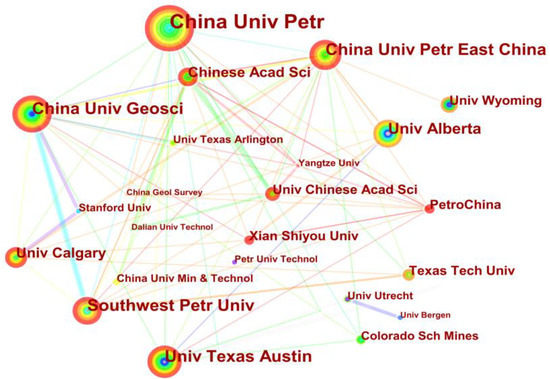
Figure 5.
Institution cooperation network.
In addition, some other representative research institutions include Curtin University, Australia (22 papers), Imperial College London, UK (39 papers), and CNRS (53 papers). The number of papers published by the China University of Petroleum ranks first in the world. In terms of centrality, the China University of Petroleum (centrality = 0.22), the University of Texas at Austin (centrality = 0:16), China University of Geosciences (centrality = 0:13), and Southwest Petroleum University (centrality = 0:12) are key nodes in the institution’s cooperation network. The China University of Petroleum is equipped with the State Key Laboratory of Oil and Gas Resources and Exploration, focusing on the multi-scale, multi-field, and multi-phase imbibition mechanism of the unconventional oil and gas reservoir exploitation process [18]. Southwest Petroleum University is located in Chengdu, Sichuan Province, China. The Sichuan Basin has the largest shale gas resources in China. At present, Southwest Petroleum University relies on the State Key Laboratory of “Oil and Gas Reservoir Geology and Development Engineering” to carry out research and development of unconventional oil and gas development theory and technology, mainly shale oil and gas. Southwest Petroleum University has made theoretical and technological breakthroughs in the imbibition mechanism of shale gas-enriched reservoirs, the optimization of imbibition in infiltrating wells, and the imbibition recovery rate [19]. In the past decade, China’s unconventional reservoir-related research institutions have made significant contributions to imbibition research.
3.1.3. Author’s Collaborative Analysis
The collaborative network of lead authors for imbibition research in unconventional reservoirs is shown in Figure 6. The author’s cooperative relationship and influence can be analyzed according to the size of the nodes in the network. The top four authors with the most publications are Hongkui Ge (35 papers), Qinhong Hu (34 papers), Dehghanpou H (33 papers), and JC Cai (32 papers). In addition, authors with larger nodes in Figure 6 are often central authors in the collaborative network and have collaborative relationships with many scholars who have the same research direction. The shale reservoirs in the Sichuan Basin and the tight sandstone reservoirs in the Ordos Basin are quite different in porosity and other parameters. The tight volcanic rocks in the Songliao Basin have obvious anisotropic characteristics. The above three sites are rich in oil and gas reserves, and the imbibition efficiency of the reservoirs in each area can be compared during the imbibition test. [20]. Porous materials such as shale have complex geometries and topologies, which limit the interaction of media in fractures during hydraulic fracturing. The low pore connectivity of shale matrices needs to be studied by combining experimental and theoretical methods [21]. There are three main fluid flow mechanisms in shale formations, and gas transport models in shale can be established according to the fractal media in the flow process. The change in liquid flux caused by surface diffusion during imbibition decreases with heat and increases significantly with imbibition capacity [22].
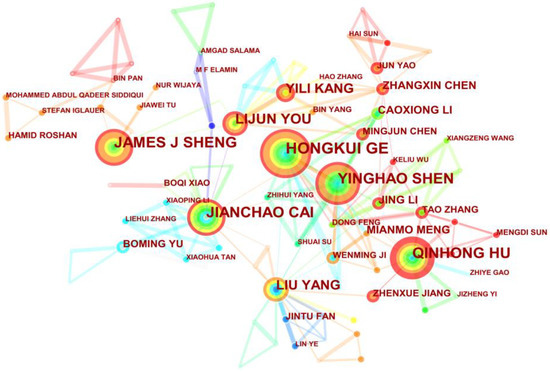
Figure 6.
Author cooperation network.
3.2. Keyword Coexistence and Evolution Analysis
The keyword is the core and essence of an article. From 2010 to 2021, keywords in different years can describe the research content in a representative and concise manner. Therefore, in various literature reviews, high-frequency keywords are often used to identify the research field of a hot topic [23]. The keyword co-occurrence network generated by CiteSpace can represent the degree of co-occurrence of keywords in the screened papers. Through this network, research hotspots and cutting-edge research directions can be found. In addition, the transition of a research field can be monitored by analyzing the evolution of keywords over time. The co-occurrence and evolution of keywords are analyzed as follows.
3.2.1. Keyword Co-occurrence
The concurrent network of keywords for imbibition research in unconventional reservoirs is shown in Figure 7. In this network, the size of the keyword is proportional to the occurrence frequency. Keywords with frequencies over 180 include “porous media” (frequency = 451), “imbibition” (frequency = 349), “flow” (frequency = 323), “model” (frequency = 236), “spontaneous imbibition” (frequency = 230), “water” (frequency = 220), “wettability” (frequency = 193), “permeability” (frequency = 189).
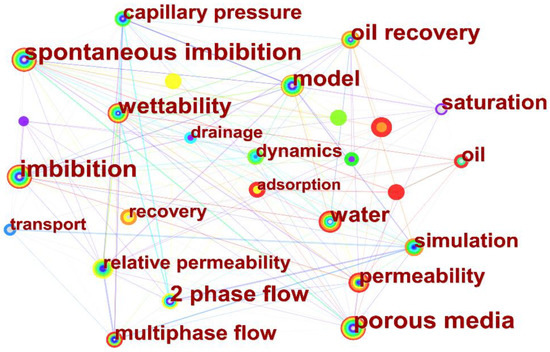
Figure 7.
Keyword co-occurrence network.
The keyword “porous media” is the most common keyword that has appeared in the past 10 years. The unconventional reservoirs in the actual production process are mostly porous media such as shale sandstone. Therefore, the rational study of imbibition in porous media is an important condition to ensure the efficient development of shale gas. Researchers have proposed various research methods for imbibition. They can be grouped into three categories, including experimental methods, theoretical model analysis, and the numerical simulation method, the specific methods of different categories are shown in Figure 8. In addition, the frequent occurrence of the keyword “water” indicates that the study of water saturation in the reservoir is a hotspot. Confined gas and self-priming fluid imbibition processes outside tight sandstone, volcanic, and shale reservoirs are different. The saturation of imbibed fluid changes with the change of medium during hydraulic fracturing of unconventional reservoirs [20]. Imbibition experiments for various fluids and media are carried out for shale samples from the Horn River Basin. The slopes of the imbibition curves of rock samples with different saturations are quite different, which can be explained by the electrostatic interaction theory [24]. Specific three-phase flooding experiments on rocks can be used to study the saturation of different rock samples. In the whole experiment, the water absorption in the rock samples was fixedly controlled, and no external pressure was applied. Through the measurement and analysis of saturation data, the influence of steady-state water inflow and time-varying saturation is obtained [25].
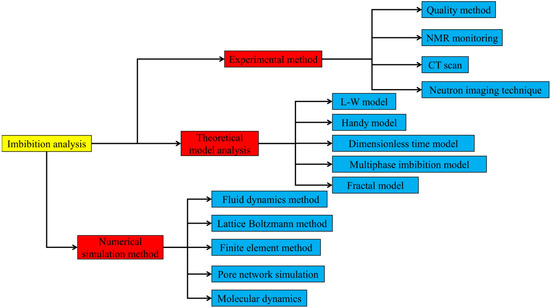
Figure 8.
Approaches of different categories for imbibition study.
3.2.2. Keyword Evolution
Since only the frequency of occurrence is considered in the concurrent network diagram of keywords in Figure 7 and the time factor is not considered, the change of the trends over time cannot be represented. To further analyze the evolution of keywords, CiteSpace software is used to generate a timeline diagram of the concurrent network of keywords, as shown in Figure 9. The numbers at the top of the timeline graph represent the year the keywords first appeared, and the lines in the graph represent the correlation coefficients between the keywords. In terms of the frequency of keywords changing with time, a large number of research keywords emerged from 2010 to 2014, indicating that the imbibition research is in the initial stage during this period, and a large number of new research directions and hot topics appeared. After 2014, new keywords appeared less frequently, but the research frequency of keywords in previous years became higher, indicating that scholars are further deepening their research on previous topics. To make the keyword development process clearer, Table 1 lists the top 10 keywords with the highest frequency and centrality related to imbibition in unconventional reservoirs in 2010–2014 and 2015–2020. According to the concurrency and evolution over time of the keywords shown in Figure 9 and Table 1, the general trend of imbibition research can be obtained. From 2010 to 2014, scholars have mainly paid close attention to “permeability”, “spontaneous imbibition”, and “porous media” in the evolution of imbibition. Since the centrality of the keyword “porous media” is as high as 0.28, it can be inferred that the study of the imbibition process in porous media plays an important role in the study of imbibition in unconventional reservoirs at this stage. The research in this period laid a solid foundation for a large number of imbibition studies in the later period.
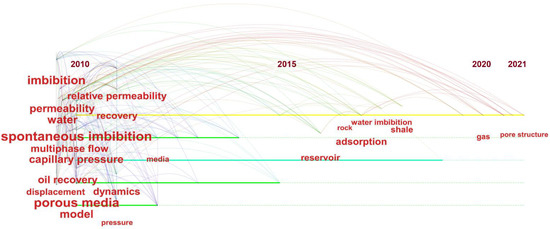
Figure 9.
Timeline view of the keyword co-occurrence network.

Table 1.
Top 15 keywords related to imbibition, 2010–2014 and 2015–2020.
In addition, some keywords have high centrality values in 2015–2020, such as “spontaneous imbibition” (centrality = 0.11), “saturation” (centrality = 0.11), “model” (centrality = 0.10), “Oil and gas circulation” (centrality = 0.09), and “permeability” (centrality = 0.07). Since most of the unconventional reservoirs such as shale are porous media, the imbibition process in porous media is a research hotspot. The research on imbibition can greatly improve the research efficiency through 3D technology modeling, and visualizing the imbibition process, which is difficult to observe in the process of oil and gas production. Therefore, the establishment of the model is also the key to the research. Generally, these keywords connect different topics in the study of imbibition processes in unconventional reservoirs. On this basis, studying the effect of spontaneous imbibition or saturation in porous media on oil and gas production is crucial for better understanding fracturing fluid regeneration efficiency and the whole process of imbibition. From 2015 to 2020, with the increase in the exploitation of shale oil and gas, the imbibition research of unconventional reservoirs developed rapidly and became a research hotspot. More and more scholars pay attention to imbibition research, and the research in this field is also more comprehensive. Volcanic rocks have significant multi-scale features. Experiments on its physical properties are helpful to understand the changes of mechanical parameters at various scales during imbibition. NMR experiments can be used to monitor imbibition fluids in porous media, which can help to study the effect of production pressure differences on long-term imbibition processes [26]. Porous media have various physical factors such as dynamic contact angles and capillary slip effects, which affect the dynamic properties during self-priming. The introduction of phase diagram components can be considered to analyze the kinetics and stability of the self-priming process [27].
3.3. Co-citation Analysis
If a paper is cited by multiple papers at the same time, a reference relationship is formed between them. Meanwhile, author and journal citations have similar definitions. Citation analysis of references, authors, and journals can be performed with Citespace software.
3.3.1. Reference
Important papers for imbibition research in unconventional reservoirs can be identified by reference mixed citation analysis. Figure 10 shows the reference mixed-cited network diagram. Each node represents a paper identified by the name of the first author and the year of publication, and its size represents the total number of citations. The size of the node is positively correlated with the number of citations of the paper. Scholars with more cited articles tend to have greater influence in the field of study. Therefore, some papers with larger nodes can be considered representative in this field. Table 2 lists the top 10 most frequently cited articles. It is worth noting that this citation frequency is obtained by CiteSpace from a selected 1810 papers, which may be different from the citation situation of papers on other academic websites.
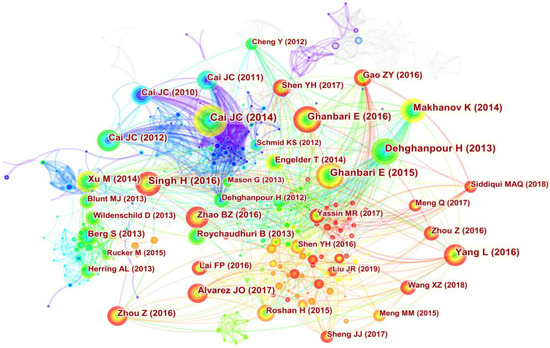
Figure 10.
Reference co-citation network.
As can be seen from Table 2, the top 10 cited papers mainly focus on experimental research on imbibition, case studies of imbibition in different geological structures, and the application of 3D imaging technology in imbibition process research. Additionally, the effect of capillary action in porous media on the imbibition process is also a research hotspot of highly cited articles. During hydraulic fracturing, the pore structure and size of porous media change, which has a great impact on imbibition efficiency and oil and gas recovery [28]. Tight rocks have complex mineral compositions, strong pore connectivity, and multi-scale characteristics. Among them, the connectivity and different pore sizes inside the porous medium greatly affect the imbibition efficiency in the experiments [29]. The physical properties of rock can be affected by moisture loss and soaking time. The shale samples from the Horn River Basin showed a linear relationship between soaking time and changes in rock mechanical parameters [30].
A modified version of the Lucas–Washburn equation is applicable to most porous self-priming media, which can be used to model capillary-driven viscous wetting and imbibition processes. The accuracy of the model is confirmed by experimental data on biphasic rock samples [31]. The imbibition model can be used to analyze the KC constant during capillary self-priming. When using the model calculation, parameters such as porosity, tortuosity, and maximum hydraulic pore size of the entire imbibition process need to be considered [32].
To confirm the latest hot papers, the top 10 most cited papers for imbibition research in unconventional reservoirs from 2016 to 2020 are summarized. Some of these articles are the same as the top 10 cited articles from 2010 to 2021, but the articles are ranked differently. This may be related to a large number of articles on imbibition that have been published in the past 5 years. The citation frequencies of these articles from 2016 to 2020 are also shown in Table 2. Highly cited articles play an important role in imbibition research. In addition, the citation frequency of these articles in 2020 is also summarized (see Table 2). Among them, most of the papers have more than 30 citations, which indicates that their research results are still important at present.
3.3.2. Author Co-citation
Author co-citation analysis can be used to identify connections between authors who are concurrently cited in the same paper. The authors’ optimized network is shown in Figure 11. Each node represents an author, and its size represents the total number of times that author has been cited. The top 10 authors of citations are Morrow, N.R. (frequency = 314, USA), Washburn, E.W. (frequency = 313, USA), J.C. Cai (frequency = 280, China), Dehghanpour, H. (frequency = 187, Canada), Mason, G. (frequency = 176, USA), Ghanbari, E. (frequency = 149.Canada), Li, K.W. (frequency = 144, USA), Blunt, M.J. (frequency = 138, England), Lenormand, R. (frequency = 135, France), and Bear, J. (frequency = 114, England). Most of these scholars are internationally renowned and widely recognized in the field of imbibition research.
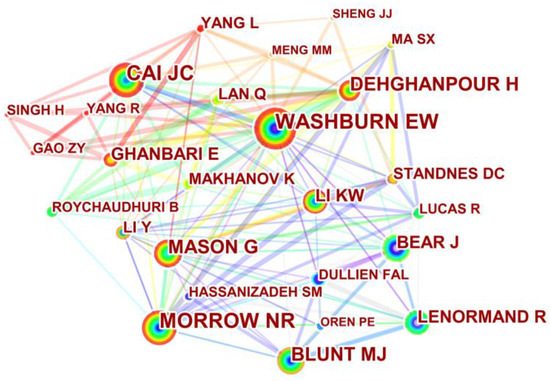
Figure 11.
Author co-citation network.

Table 2.
Top 10 cited articles on imbibition in unconventional reservoirs.
Table 2.
Top 10 cited articles on imbibition in unconventional reservoirs.
| Author | Title | Cited Frequency | Cited Frequency (Per Year) | Cited Frequency from 2016 to 2020 | Cited Frequency in 2020 |
|---|---|---|---|---|---|
| Berg et al. | Real-time 3D imaging of Haines jumps in porous media flow [33] | 346 | 38.4 | 246 | 63 |
| Cai et al. | Generalized Modeling of Spontaneous Imbibition Based on Hagen-Poiseuille Flow in Tortuous Capillaries with Variably Shaped Apertures [34] | 335 | 41.88 | 236 | 57 |
| Cai et al. | A Discussion of the Effect of Tortuosity on the Capillary Imbibition in Porous Media [35] | 294 | 26.73 | 178 | 32 |
| Cai et al. | Fractal Characterization of Spontaneous Co-current Imbibition in Porous Media [36] | 257 | 21.42 | 168 | 23 |
| Dehghanpour et al. | Spontaneous Imbibition of Brine and Oil in Gas Shales: Effect of Water Imbibition and Resulting Microfractures [37] | 243 | 27 | 171 | 32 |
| Zhao et al. | Wettability control on multiphase flow in patterned microfluidics [38] | 224 | 37.33 | 163 | 59 |
| Huber et al. | Soft matter in hard confinement: phase transition thermodynamics, structure, texture, diffusion, and flow in nanoporous media [39] | 202 | 28.86 | 162 | 30 |
| Cai et al. | An analytical model for spontaneous imbibition in fractal porous media including gravity [40] | 190 | 19 | 103 | 16 |
| Dehghanpour et al. | Liquid Intake of Organic Shales [41] | 179 | 17.9 | 121 | 24 |
| Krevor et al. | Capillary trapping for geologic carbon dioxide storage—From pore-scale physics to field-scale implications [42] | 175 | 25 | 132 | 41 |
In addition, according to the countries of the most cited authors, imbibition research in unconventional reservoirs is progressing rapidly in China, the United States, and Canada. In particular, the imbibition research in Canada and the United States has a long history and rich research results.
In addition, a screening analysis of articles investigating imbibition studies in unconventional reservoirs from 2015 to 2021 is performed to detect the most recent and most cited authors. The top 10 authors are J.C. Cai (frequency = 253, China), Washburn, E.W. (frequency = 252, USA), Morrow, N.R. (frequency = 245, USA), Dehghanpour, H. (frequency = 118, Canada), Mason, G. (frequency = 158, USA), Ghanbari, E. (frequency = 149, Canada), Li, K.W. (frequency = 126, USA), Blunt, M.J. (frequency = 87, England), Liu Yang (frequency = 87, China), and Lenormand, R. (frequency = 84, France). Although the latest rankings vary, most of the authors are the same as the top 10 authors from 2010 to 2021, and their findings have significant implications for the current study.
3.3.3. Journal Co-citation
Table 3 lists the top ten journals for the number of papers published in unconventional reservoir absorption research. The number of papers published is in line with the importance attached by the journal to the study of unconventional reservoir imbibition. The Journal of Petroleum Science and Engineering ranked first with 170 papers (9.392%), the Journal of Energy and Fuels ranked second with 116 papers (6.409%), and the Journal of Porous Media Transportation ranked third with 98 papers (5.414%). The above three journals have published more than 90 articles in the field of unconventional reservoir imbibition research in the past ten years, indicating that these journals are recognized by scholars in this field. The journal self-selection network produced by CiteSpace can be used to identify journals with the most citations, as shown in Figure 12. The size of each node represents the citation frequency of a journal. Generally, journals with higher citation frequency have greater authority and influence in this field. To better represent journal citations, Table 4 lists the top 10 journals in unconventional reservoir imbibition research citations. It is worth noting that the three most frequently cited journals also belong to the top three journals in terms of the number of publications. It can be seen that these three journals have greater influence in the field of imbibition research, and the quality of the papers included is higher.

Table 3.
Top 10 journals by the number of publications.
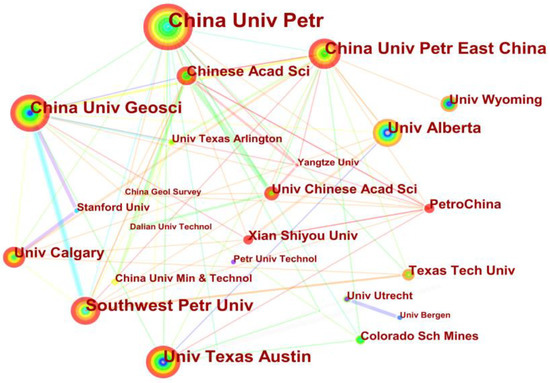
Figure 12.
Journal co-citation network.

Table 4.
Top 10 journals by citations.
3.4. Cluster Analysis
Cluster analysis is an important data mining technique to detect hidden topics in text data. CiteSpace uses the titles, keywords, or noun phrases in the abstracts of cited papers to perform cluster analysis. Cluster labels can be created based on a latent semantic index (LSI) algorithm, a log-likelihood ratio (LLR) algorithm, or a mutual information (MI) algorithm. Then, the research data is divided into different grid cells, and potential clusters of research topics and their interrelationships are identified. Size (see the second column) indicates the number of papers contained in each cluster. The silhouette score (see the third column) is an important measure of cluster quality. The larger the silhouette score (with a maximum value of 1.00), the more uniform the clusters. All clusters in this study had silhouette scores over 0.70. This shows that the clustering performance in the graph is good and that the content of each paper matches its clustering well. Average Citation Year (see the fifth column) represents the average publication year for each cluster, which can determine whether a cluster includes older or more recent papers. Most of these clusters are papers with an average publication year of around 2012, and their average publication year is also very close. This shows that a large number of high-quality papers on imbibition research in unconventional reservoirs were published around 2012 and have been cited in more recent years.
According to the clustering results in Figure 13 and Table 5, the main research topics of articles published on unconventional reservoirs over the years are determined. Generally speaking, from the perspective of research content, it can be divided into six categories: spontaneous imbibition research, imbibition process research in porous media, liquid flow imbibition research, capillary imbibition research, imbibition study for oil recovery, and shale contact angle research. The imbibition process is primarily driven spontaneously by capillary forces, so spontaneous imbibition (cluster #0) is the largest cluster throughout the study. In addition, in shale oil and gas production, the study of the imbibition process in porous media (cluster #1) is a research hotspot and an important research direction for unconventional reservoir absorption. During the severity study of saturated porous media, the effect of pore fluid flow (cluster #2) velocity on the infiltration has always been a hot research area. The above three clusters can be considered as important directions in imbibition research due to their high centrality and many representative articles. At present, it is difficult to study the imbibition process at the microscopic scale, so capillary imbibition (cluster #3) is also a research hotspot. The increase in the efficiency of spontaneous imbibition (cluster #0) can indirectly increase the oil and gas recovery production, so the research related to oil and gas recovery (cluster #4) is also a popular cluster. In the study of shale imbibition, contact angle (cluster #5) can be used to evaluate shale wettability and spontaneous imbibition in tortuous micro-nanopores, so the study of contact angle is also becoming a hot research topic.
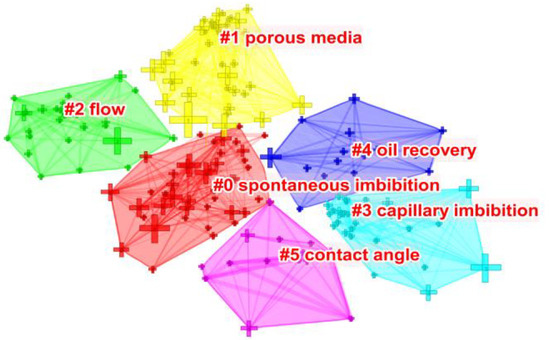
Figure 13.
Main clusters in imbibition research.

Table 5.
Six main clusters in imbibition studies.
4. Discussion
4.1. Existing Knowledge Domains
According to the results of scientometric analysis, the comprehensive knowledge map of imbibition research in unconventional reservoirs is shown in Figure 14. Combined with the Citespace system analysis map, the main research on imbibition in unconventional reservoirs from 2010 to 2021 is summarized in various aspects. Existing research results and areas of knowledge are systematically discussed to advance the understanding of the existing body of knowledge in the field.
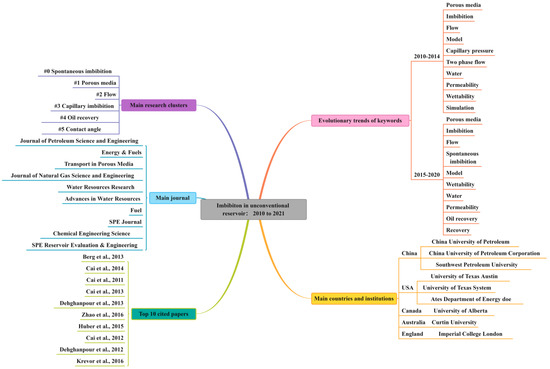
Figure 14.
Comprehensive knowledge map of imbibition research in unconventional reservoirs: 2010–2021.
4.1.1. Year-by-Year Growth Trend
The number of papers on imbibition research in unconventional reservoirs has grown rapidly. The number of publications has increased significantly since 2014 at an average annual growth rate of 23.5%, and publications increased from 83 in 2014 to 294 in 2020, the number of citations increased from 1183 in 2014 to 6014 in 2020, with an average annual growth rate of 31.3%. In recent years, China has made rapid progress in the exploitation of unconventional oil and gas such as shale oil. The number of publications has increased from 23 in 2014 to 140 in 2020, and the average growth rate has reached an astonishing 35.1%. The number of citations increased from 138 in 2014 to 2102 in 2020, with an average growth rate of 57.4%. It can be seen that since 2015, a large number of researchers, especially Chinese scholars, have paid more attention to the field of imbibition in unconventional reservoirs.
4.1.2. National Cooperation Network
In the national cooperative network of unconventional reservoir imbibition research, the five countries with the largest number of publications are China, the United States, Canada, Australia, and Iran. These countries have carried out much research on imbibition in unconventional reservoirs and published a large number of influential articles. As the country with the largest number of articles published, China has made the most outstanding contribution to the development of imbibition research in unconventional reservoirs. In terms of international cooperation, China has closely cooperated with the United States, India, France, Norway, Germany, Australia, Canada, and other countries to conduct in-depth research on the relationship between the imbibition process of unconventional reservoirs and oil and gas production efficiency.
4.1.3. Main Research Scholars
The main authors of unconventional reservoir imbibition research are mainly distributed in China and the United States. The number of publications and the number of citations can be an important measure of author influence. The top four authors with the most published articles are Hongkui Ge (35 papers, China), Qinhong Hu (34 papers, China), Dehghanpou, H. (33 papers, Canada), and J.C. Cai (32 papers, China). According to different research methods such as imbibition experimental research methods, model research methods, and numerical simulation research methods in unconventional reservoirs, researchers have formed four major cooperative networks. The main central authors in the network are Hongkui Ge, Qinhong Hu, Yinghao Shen, and J.C. Cai; they have also established cooperative relations with many scholars in the same direction.
Author co-citation analysis can be used to identify linkages between authors who are concurrently cited in the same paper, and authors with a higher number of citations typically have significant influence in the field. The top 10 authors and citations are as follows: Morrow, N.R. (frequency = 314, USA), Washburn, E.W. (frequency = 313, USA), J.C. Cai (frequency = 280, China), Dehghanpour, H. (frequency = 187, Canada), Mason, G. (frequency = 176, USA), Ghanbari, E. (frequency = 149, Canada), Li, K.W. (frequency = 144, USA), Blunt, M.J. (frequency = 138, England), Lenormand, R. (frequency = 135, France), and Bear, J. (frequency = 114, England). These authors have been studying the imbibition process in unconventional reservoirs for many years, and their research results and published articles have been recognized by researchers around the world.
Authors who publish more articles are not necessarily highly central, but authors with higher centrality tend to have greater influence in the field. In terms of author centrality, the top four authors with the highest overall rankings are J.C. Cai (centrality = 0:24, China) and Dehghanpour, H. (centrality = 0:17, Canada), Blunt, M.J. (centrality = 0:16, England), and Morrow, N.R. (centrality = 0:13, USA). In terms of article citations, three of the top five cited research articles are published by Chinese scholar J.C. Cai. This means that the works published by the scholar have great influence in the research field, and are recognized and highly evaluated by scholars all over the world.
4.1.4. Keyword Co-occurrence Network
Keywords are the core and essence of an article. From 2010 to 2021, keywords in different years can describe the research content in a representative and concise manner. Therefore, in various literature reviews, high-frequency keywords are often used to identify the research field of a hot topic. The keyword co-occurrence network generated by CiteSpace can represent the degree of co-occurrence of keywords in the screened papers. Through this network, research hotspots and frontier research directions can be found. In addition, the transition of a research field can also be monitored by analyzing the evolution of keywords over time. The co-occurrence and evolution of keywords are analyzed as follows.
In the concurrent network of keywords for imbibition research in unconventional reservoirs, the top 10 keywords in terms of frequency include “porous media” (frequency = 451), “imbibition” (frequency = 349), “flow” (frequency = 323), “model” (frequency = 236), “spontaneous imbibition” (frequency = 230), “water” (frequency = 220), “wettability” (frequency = 193), “permeability” (frequency = 189), “two-phase flow” (frequency = 151), and “dynamics” (frequency = 144). Among the top three keywords in terms of frequency, the keyword “porous media” ranks first; this is because there are many unconventional reservoirs in the actual mining process. It is a porous medium such as shale sandstone, so the rational study of imbibition in a porous medium is an important condition to ensure the efficient exploitation of shale gas. The frequency of occurrence of the keyword “flow” is the third. This is because hydraulic fracturing technology is widely used in the oil and gas extraction process of unconventional reservoirs. Therefore, the influence of liquid flow velocity and water pressure on the imbibition process is also a research hotspot.
4.1.5. Publication Journals
Among the top ten journals with the number of articles published on the subject of unconventional reservoir imbibition, The Journal of Petroleum Science and Engineering ranks first for the most published papers, the Journal of Energy and Fuels ranks second, and the Journal of Transportation in Porous Media ranks third. Since the imbibition usually occurs along with the exploitation of oil and gas, the study of imbibition is usually to solve the problems in oil and gas exploitation, so the journals of petroleum science and engineering have published the largest number of papers. In addition to the imbibition problem in the process of oil and gas exploitation, the research on imbibition in unconventional reservoirs is also crucial in the production of various energy sources and fuels. Imbibition usually occurs in porous media, and has a great relationship with the flow rate of liquid in porous media, so the number of articles published by transport journals in porous media is also very large. These journals with a high number of publications are highly recognized in the field of unconventional reservoir imbibition research, and their influence is also greater.
4.1.6. Main Cluster Analysis
Cluster analysis is an important data mining technique that can detect hidden topics in text data. The data collected in this paper generated a total of six clusters, and cluster #0 ranked first in the order of cluster size, which consisted of 43 keywords. The silhouette score is an important indicator to measure the quality of the cluster, which is related to the uniformity of the cluster. All clusters in this study had silhouette scores over 0.70. This shows that the clustering performance in the graph is excellent, and the content of the paper matches its clustering well. Average Citation Year represents the average publication year for each cluster, which determines whether a cluster includes older or more recent papers. Most of these clusters are papers with an average publication year of around 2012, and their average publication year is also very close. This shows that a large number of high-quality papers on imbibition research in unconventional reservoirs were published around 2012 and have been cited in recent years.
5. Conclusions
This study reviews imbibition studies in unconventional reservoirs from 2010 to 2021 through a scientometric analysis of 1810 papers. Collaborative analysis of countries, institutions, and authors is carried out with the help of CiteSpace software. Based on the above analysis, the main conclusions are summarized as follows. With the rapid growth of oil and gas production, the number of publications and citations of papers related to imbibition in unconventional oil and gas reservoirs around the world has increased year by year. China has also published a large number of high-quality papers and research results related to imbibition research in unconventional oil and gas reservoirs. In terms of published papers related to imbibition research, China is the country with the largest number of published papers. The China University of Petroleum is the research institution with the largest number of publications. The Journal of Petroleum Science and Engineering ranks first among all journals for the number of papers published. Many well-known scholars have conducted in-depth research on imbibition. J.C. Cai, Dehghanpour, H., Blunt, M.J., and Morrow, N.R. are the top four authors with the highest centrality. J.C. Cai has the highest centrality among all research scholars, which means that the scholar has a huge influence in the research field. Imbibition model research in porous media and the effect of wettability on imbibition are hot topics in 2010–2021. In terms of cluster analysis, “Spontaneous imbibition”, “Porous media”, “Flow”, “Capillary imbibition”, “Oil recovery”, and “Contact angle” are the six main clusters. “Spontaneous imbibition” and “Porous media” became the top two clusters with a high frequency.
The above analysis is only based on the data retrieved from the scientific core network database, and some other types of databases may be considered in the future to generate a more comprehensive knowledge graph for imbibition research. In addition, some keywords with similar meanings should also be considered when conducting keyword concurrency and evolution analysis. In cluster analysis, more accurate results can be obtained by using multiple clustering methods for effect comparison, which can better organize the current state of imbibition research.
Author Contributions
Conceptualization, L.Y. and D.Y.; methodology, L.Y.; software, D.Y.; validation, J.H., C.L. and J.J.; formal analysis, M.H.; investigation, C.L.; resources, D.Y.; data curation, Y.L.; writing—original draft preparation, D.Y.; writing—review and editing, D.Y.; visualization, D.Y.; supervision, L.Y.; project administration, L.Y.; funding acquisition, L.Y. All authors have read and agreed to the published version of the manuscript.
Funding
The research is funded by the National Natural Science Foundation of China (no. 11702296), the Natural Science Foundation of China (no. 41941018), the Fundamental Research Funds for the Central Universities (no. 2462019YJRC011), and the China Geological Survey (no. DD20190232). Major Science and Technology Project of Yunnan Province (no. 202002AF080003).
Institutional Review Board Statement
Not applicable.
Informed Consent Statement
Not applicable.
Data Availability Statement
All the data is available within the manuscript.
Acknowledgments
We confirm that the authors included in this section have agreed to confirm.
Conflicts of Interest
The authors declare no conflict of interest.
References
- Davies, R.J.; Almond, S.; Ward, R.S.; Jackson, R.B.; Adams, C.; Worrall, F.; Herringshaw, L.G.; Gluyas, J.G.; Whitehead, M.A. Oil and gas wells and their integrity: Implications for shale and unconventional resource exploitation. Mar. Pet. Geol. 2014, 56, 239–254. [Google Scholar] [CrossRef]
- Zhang, P.M.; Tweheyo, M.T.; Austad, T. Wettability alteration and improved oil recovery by spontaneous imbibition of seawater into chalk: Impact of the potential determining ions Ca2+, Mg2+, and SO42−. Colloid Surf. A Physicochem. Eng. Asp. 2007, 301, 199–208. [Google Scholar] [CrossRef]
- Lin, D.; Wang, J.; Yuan, B.; Shen, Y. Review on gas flow and recovery in unconventional porous rocks. Adv. Geo-Energy Res. 2017, 1, 39–53. [Google Scholar] [CrossRef]
- You, Q.; Wang, H.; Zhang, Y.; Liu, Y.F.; Fang, J.C.; Dai, C.L. Experimental study on spontaneous imbibition of recycled fracturing flow-back fluid to enhance oil recovery in low permeability sandstone reservoirs. J. Pet. Sci. Eng. 2018, 166, 375–380. [Google Scholar] [CrossRef]
- Cheng, Z.L.; Ning, Z.F.; Ye, X.F.; Wang, Q.; Zhang, W.T. New insights into spontaneous imbibition in tight oil sandstones with NMR. J. Pet. Sci. Eng. 2019, 179, 455–464. [Google Scholar] [CrossRef]
- Jin, J.F.; Sun, J.S.; Rong, K.S.; Lv, K.H.; Nguyen, T.A.H.; Wang, R.; Huang, X.B.; Bai, Y.R.; Liu, J.P.; Wang, J.T. Gas-Wetting Alteration by Fluorochemicals and Its Application for Enhancing Gas Recovery in Gas-Condensate Reservoirs: A Review. Energies 2020, 13, 4591. [Google Scholar] [CrossRef]
- Cai, J.C.; Luo, L.; Ye, R.; Zeng, X.F.; Hu, X.Y. Recent Advances on Fractal Modeling of Permeability for Fibrous Porous Media. Patterns Scaling Nat. Soc. 2015, 23, 9. [Google Scholar] [CrossRef]
- Tian, W.B.; Wu, K.L.; Gao, Y.; Chen, Z.X.; Gao, Y.L.; Li, J. A Critical Review of Enhanced Oil Recovery by Imbibition: Theory and Practice. Energy Fuels 2021, 35, 5643–5670. [Google Scholar] [CrossRef]
- Diamantopoulos, E.; Durner, W. Dynamic Nonequilibrium of Water Flow in Porous Media: A Review. Vadose Zone J. 2012, 11, 18. [Google Scholar] [CrossRef]
- Gambaryan-Roisman, T. Liquids on porous layers: Wetting, imbibition and transport processes. Curr. Opin. Colloid Interface Sci. 2014, 19, 320–335. [Google Scholar] [CrossRef]
- Olawumi, T.O.; Chan, D.W.M. A scientometric review of global research on sustainability and sustainable development. J. Clean Prod. 2018, 183, 231–250. [Google Scholar] [CrossRef]
- Chen, C.M. CiteSpace II: Detecting and visualizing emerging trends and transient patterns in scientific literature. J. Am. Soc. Inf. Sci. Technol. 2006, 57, 359–377. [Google Scholar] [CrossRef]
- Freeman, L. A set of measures of centrality based on betweenness. Sociometry 1977, 40, 35–41. [Google Scholar] [CrossRef]
- Wang, Q.; Chen, X.; Jha, A.N.; Rogers, H. Natural gas from shale formation—The evolution, evidences and challenges of shale gas revolution in United States. Renew. Sustain. Energy Rev. 2014, 30, 1–28. [Google Scholar] [CrossRef]
- Podoba, Z.S.; Lavrova, A.V. “Shale Revolution” In The Usa And Its Impact on the International Trade Flows of Oil and Gas. Mosc. Univ. Econ. Bull. 2021, 1, 3–32. [Google Scholar] [CrossRef]
- Liu, X.J.; Xiong, J.; Liang, L.X. Investigation of pore structure and fractal characteristics of organic-rich Yanchang formation shale in central China by nitrogen adsorption/desorption analysis. J. Nat. Gas Sci. Eng. 2015, 22, 62–72. [Google Scholar] [CrossRef]
- Tang, J.Z.; Li, J.W.; Tang, M.R.; Du, X.F.; Yin, J.; Guo, X.Y.; Wu, K.; Xiao, L.Z. Investigation of multiple hydraulic fractures evolution and well performance in lacustrine shale oil reservoirs considering stress heterogeneity. Eng. Fract. Mech. 2019, 218, 18. [Google Scholar] [CrossRef]
- Zou, C.N.; Yang, Z.; Zhu, R.K.; Zhang, G.S.; Hou, L.H.; Wu, S.T.; Tao, S.Z.; Yuan, X.J.; Dong, D.Z.; Wang, Y.M.; et al. Progress in China’s Unconventional Oil & Gas Exploration and Development and Theoretical Technologies. Acta Geol. Sin.-Engl. Ed. 2015, 89, 938–971. [Google Scholar]
- Li, H.T.; Wei, N.; Jiang, L.; Zhao, J.Z.; Cui, Z.J.; Sun, W.T.; Zhang, L.H.; Zhou, S.W.; Xu, H.M.; Zhang, X.C.; et al. Evaluation of Experimental Setup and Procedure for Rapid Preparation of Natural Gas Hydrate. Energies 2020, 13, 531. [Google Scholar] [CrossRef]
- Ge, H.K.; Yang, L.; Shen, Y.H.; Ren, K.; Meng, F.B.; Ji, W.M.; Wu, S. Experimental investigation of shale imbibition capacity and the factors influencing loss of hydraulic fracturing fluids. Pet. Sci. 2015, 12, 636–650. [Google Scholar] [CrossRef]
- Hu, Q.H.; Ewing, R.P.; Rowe, H.D. Low nanopore connectivity limits gas production in Barnett formation. J. Geophys. Res.-Solid Earth 2015, 120, 8073–8087. [Google Scholar] [CrossRef]
- Cai, J.C.; Lin, D.L.; Singh, H.; Wei, W.; Zhou, S.W. Shale gas transport model in 3D fractal porous media with variable pore sizes. Mar. Pet. Geol. 2018, 98, 437–447. [Google Scholar] [CrossRef]
- Chen, C.M.; Chen, Y.; Horowitz, M.; Hou, H.Y.; Liu, Z.Y.; Pellegrino, D. Towards an explanatory and computational theory of scientific discovery. J. Informetr. 2009, 3, 191–209. [Google Scholar] [CrossRef]
- Binazadeh, M.; Xu, M.X.; Zolfaghari, A.; Dehghanpour, H. Effect of Electrostatic Interactions on Water Uptake of Gas Shales: The Interplay of Solution Ionic Strength and Electrostatic Double Layer. Energy Fuels 2016, 30, 992–1001. [Google Scholar] [CrossRef]
- Dehghanpour, H.; DiCarlo, D.A. Drainage of Capillary-Trapped Oil by an Immiscible Gas: Impact of Transient and Steady-State Water Displacement on Three-Phase Oil Permeability. Transp. Porous Media 2013, 100, 297–319. [Google Scholar] [CrossRef]
- Shen, Y.H.; Meng, M.M.; Liu, T.; Ge, H.K.; Zhang, Y.L. Impact of Petrophysical Properties on Hydraulic Fracturing and Development in Tight Volcanic Gas Reservoirs. Geofluids 2017, 2017, 5235140. [Google Scholar] [CrossRef]
- Li, C.X.; Shen, Y.H.; Ge, H.K.; Zhang, Y.J.; Liu, T. Spontaneous imbibition in fractal tortuous micro-nano pores considering dynamic contact angle and slip effect: Phase portrait analysis and analytical solutions. Sci. Rep. 2018, 8, 13. [Google Scholar] [CrossRef]
- Meng, M.M.; Ge, H.K.; Shen, Y.H.; Ji, W.M. Evaluation of the Pore Structure Variation During Hydraulic Fracturing in Marine Shale Reservoirs. J. Energy Resour. Technol.-Trans. ASME 2021, 143, 10. [Google Scholar] [CrossRef]
- Yang, L.; Ge, H.K.; Shi, X.; Cheng, Y.F.; Zhang, K.H.; Chen, H.; Shen, Y.H.; Zhang, J.J.; Qu, X.M. The effect of microstructure and rock mineralogy on water imbibition characteristics in tight reservoirs. J. Nat. Gas Sci. Eng. 2016, 34, 1461–1471. [Google Scholar] [CrossRef]
- Lan, Q.; Ghanbari, E.; Dehghanpour, H.; Hawkes, R. Water Loss Versus Soaking Time: Spontaneous Imbibition in Tight Rocks. Energy Technol. 2014, 2, 1033–1039. [Google Scholar] [CrossRef]
- Alinejad, A.; Dehghanpour, H. Evaluating porous media wettability from changes in Helmholtz free energy using spontaneous imbibition profiles. Adv. Water Resour. 2021, 157, 8. [Google Scholar] [CrossRef]
- Wei, W.; Cai, J.C.; Xiao, J.F.; Meng, Q.B.; Xiao, B.Q.; Han, Q. Kozeny-Carman constant of porous media: Insights from fractal-capillary imbibition theory. Fuel 2018, 234, 1373–1379. [Google Scholar] [CrossRef]
- Berg, S.; Ott, H.; Klapp, S.A.; Schwing, A.; Neiteler, R.; Brussee, N.; Makurat, A.; Leu, L.; Enzmann, F.; Schwarz, J.O.; et al. Real-time 3D imaging of Haines jumps in porous media flow. Proc. Natl. Acad. Sci. USA 2013, 110, 3755–3759. [Google Scholar] [CrossRef] [PubMed]
- Cai, J.C.; Perfect, E.; Cheng, C.L.; Hu, X.Y. Generalized Modeling of Spontaneous Imbibition Based on Hagen-Poiseuille Flow in Tortuous Capillaries with Variably Shaped Apertures. Langmuir 2014, 30, 5142–5151. [Google Scholar] [CrossRef] [PubMed]
- Cai, J.C.; Yu, B.M. A Discussion of the Effect of Tortuosity on the Capillary Imbibition in Porous Media. Transp. Porous Media 2011, 89, 251–263. [Google Scholar] [CrossRef]
- Cai, J.C.; Yu, B.M.; Zou, M.Q.; Luo, L. Fractal Characterization of Spontaneous Co-current Imbibition in Porous Media. Energy Fuels 2010, 24, 1860–1867. [Google Scholar] [CrossRef]
- Dehghanpour, H.; Lan, Q.; Saeed, Y.; Fei, H.; Qi, Z. Spontaneous Imbibition of Brine and Oil in Gas Shales: Effect of Water Adsorption and Resulting Microfractures. Energy Fuels 2013, 27, 3039–3049. [Google Scholar] [CrossRef]
- Zhao, B.Z.; MacMinn, C.W.; Juanes, R. Wettability control on multiphase flow in patterned microfluidics. Proc. Natl. Acad. Sci. USA 2016, 113, 10251–10256. [Google Scholar] [CrossRef]
- Huber, P. Soft matter in hard confinement: Phase transition thermodynamics, structure, texture, diffusion and flow in nanoporous media. J. Phys.-Condes. Matter 2015, 27, 43. [Google Scholar] [CrossRef]
- Cai, J.C.; Hu, X.Y.; Standnes, D.C.; You, L.J. An analytical model for spontaneous imbibition in fractal porous media including gravity. Colloid Surf. A Physicochem. Eng. Asp. 2012, 414, 228–233. [Google Scholar] [CrossRef]
- Dehghanpour, H.; Zubair, H.A.; Chhabra, A.; Ullah, A. Liquid Intake of Organic Shales. Energy Fuels 2012, 26, 5750–5758. [Google Scholar] [CrossRef]
- Krevor, S.; Blunt, M.J.; Benson, S.M.; Pentland, C.H.; Reynolds, C.; Al-Menhali, A.; Niu, B. Capillary trapping for geologic carbon dioxide storage—From pore scale physics to field scale implications. Int. J. Greenh. Gas Control 2015, 40, 221–237. [Google Scholar] [CrossRef]
Disclaimer/Publisher’s Note: The statements, opinions and data contained in all publications are solely those of the individual author(s) and contributor(s) and not of MDPI and/or the editor(s). MDPI and/or the editor(s) disclaim responsibility for any injury to people or property resulting from any ideas, methods, instructions or products referred to in the content. |
© 2023 by the authors. Licensee MDPI, Basel, Switzerland. This article is an open access article distributed under the terms and conditions of the Creative Commons Attribution (CC BY) license (https://creativecommons.org/licenses/by/4.0/).